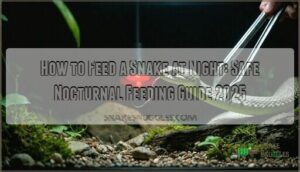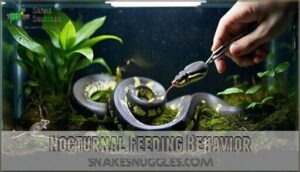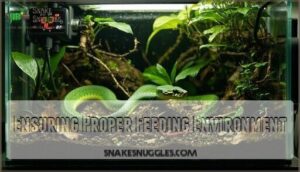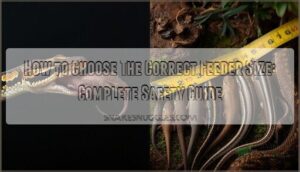This site is supported by our readers. We may earn a commission, at no cost to you, if you purchase through links.
 Feeding your snake at night isn’t as tricky as it might seem – it’s actually when many species are naturally most active.
Feeding your snake at night isn’t as tricky as it might seem – it’s actually when many species are naturally most active.
First, you’ll want to create the right environment by dimming the lights and ensuring the temperature is at a comfortable level for your serpentine friend.
Using tongs (never your hands!), place the appropriate prey item in a designated feeding box.
The key is to be patient and let your snake do its thing in the dark.
Once your snake has finished its midnight snack, carefully return it to its regular habitat.
Just like us with late-night cravings, timing and environment make all the difference in a successful feeding session.
Table Of Contents
- Key Takeaways
- How to Feed a Snake at Night?
- Feeding Snakes in Low Light
- Maximum Time Without Feeding
- Avoid These Feeding Mistakes
- Nocturnal Feeding Behavior
- Preparing Nighttime Feeding Space
- Understanding Snake Digestion at Night
- Ensuring Proper Feeding Environment
- Frequently Asked Questions (FAQs)
- Can I feed my snake in the dark?
- How long can a snake go without eating?
- What not to do when feeding a snake?
- Do snakes look for food at night?
- Can I use red light during nighttime feedings?
- How do I prevent escape attempts during night feeding?
- Should I adjust prey size for nocturnal feedings?
- Are there specific snake species that prefer daytime feeding?
- How long should I wait before handling after night feeding?
- How to transition snakes from live to frozen prey?
- Conclusion
Key Takeaways
- Dim the lights and use red-tinted flashlights to create a calm, natural environment for your snake’s nocturnal feeding.
- Always use tongs to offer appropriately sized prey, and avoid handling your snake before or after meals to reduce stress and prevent regurgitation.
- Keep the enclosure secure and maintain temperatures between 80-85°F to support healthy digestion and prevent escape attempts.
- Be patient and let your snake hunt at its own pace—don’t force-feed or disrupt its natural feeding instincts.
How to Feed a Snake at Night?
Feeding snakes at night taps into their nocturnal habits and natural hunting instincts.
Nighttime feeding lets your snake embrace its wild side, following natural instincts for a healthier, happier pet.
You’ll want to dim regular lights and use red-tinted flashlights to observe without spooking your serpent. Watch for key feeding cues like increased tongue flicking and coiling behavior—these signal they’re ready to strike.
Maintain proper temperature between 80-85°F and keep noise minimal. Night feeding tips include choosing appropriate prey size and using motion-activated feeders to trigger their predatory response.
This approach to snake care respects their biological clock for ideal snake nutrition. Using tongs can mimic natural hunting behavior during these nocturnal feedings.
Feeding Snakes in Low Light
Creating ideal low light feeding conditions transforms your snake’s dining experience.
Red Light Use preserves their natural night vision while allowing observation during feeding snakes at night.
Install dim infrared bulbs or use Night Vision cameras to monitor without disruption.
Light Sensitivity varies between species, but most nocturnal hunters prefer minimal illumination.
Shadow Impact creates secure feeding zones—snakes feel safer when they can’t see you clearly.
Prey Visibility shouldn’t be completely eliminated; subtle lighting helps snakes locate food.
A 12-hour cycle helps regulate their natural sleep patterns.
Avoid bright flashlights during night time snake feeding sessions.
This low light feeding approach mimics wild conditions perfectly.
Maximum Time Without Feeding
Understanding your snake’s fasting duration gives you complete control over their health and feeding schedule. Species variation plays a vital role—adult ball pythons can survive months without food, while juveniles need weekly meals.
The health impact of extended fasting varies dramatically based on age and size. Adult ball pythons, for example, can experience longer periods without food, but it’s important to know their typical fasting limits.
Monitor these key factors for ideal snake feeding frequency:
- Weight monitoring every two weeks during fasting periods
- Age-specific snake feeding intervals (juveniles: 1-2 weeks, adults: 4-6 weeks)
- Seasonal changes affecting natural snake feeding schedule patterns
- Environmental temperature impacts on metabolism and digestion
- Vet consultation when fasting exceeds normal species limits
Avoid These Feeding Mistakes
Mistakes can sabotage your snake’s health faster than you’d expect.
These feeding blunders create stress and potential health complications for nocturnal snake care:
- Forced Feeding dehydrated snakes disrupts their natural physiology and creates dangerous dehydration risks
- Erratic Schedules confuse your snake’s internal feeding clock and appetite cycles
- Incorrect Prey sizes cause regurgitation or choking hazards during nighttime feeding risks
- Unnecessary Handling stresses snakes before meals
To guarantee proper digestion, avoid handling after feeding.
Nocturnal Feeding Behavior
Your snake’s body language tells a fascinating story during nighttime hours.
Every flick of the tongue and coil of the body reveals your snake’s secret nighttime world.
Nocturnal snakes naturally align their feeding patterns with prey activity cycles, making them more responsive to scent cues after dark.
Watch for increased tongue flicking—this signals prey scenting behavior and heightened hunting readiness.
When your snake exhibits coiling readiness by positioning itself in an S-curve, it’s prime feeding time.
Moon influence affects some species’ activity levels, though captive snakes rely more on temperature and humidity cues.
Habitat mimicry becomes important here—dimmed lighting triggers natural hunting instincts.
Consider scent camouflage techniques when introducing prey, as nocturnal snake care requires understanding these behavioral patterns.
Proper thawing helps maintain frozen prey nutrition.
Snake night feeding success depends on recognizing these natural nocturnal feeding behaviors rather than forcing daytime schedules.
Preparing Nighttime Feeding Space
Your snake feeding night setup determines success or failure. Start with red light illumination—it won’t disturb your snake’s natural vision while allowing you to observe feeding behavior.
Create a secure enclosure by checking all latches and gaps before introducing prey. Dim lighting helps mimic habitat conditions that trigger hunting instincts.
Use scent camouflage techniques when handling prey to avoid transferring human odors. Gradually introduce your snake to the feeding area to reduce stress and prevent defensive behaviors.
Remove water dishes temporarily to prevent drowning accidents. Promoting ecosystem biodiversity can also benefit local snake populations.
These nocturnal behavior considerations and feeding snakes in dark environments require patience, but proper snake feeding techniques guarantee safe, successful meals every time.
Understanding Snake Digestion at Night
Once you’ve set up your nighttime feeding space, your snake’s digestive machinery shifts into a fascinating nocturnal rhythm. Snake digestion operates differently in darkness compared to daylight hours.
Nocturnal metabolism runs at a reduced pace due to cooler nighttime temperatures, which directly affects how quickly your snake processes its meal.
Here’s what happens during nocturnal digestion:
- Your snake’s body temperature drops naturally at night, slowing enzyme activity
- Digestive processes can take 20-30% longer in cooler conditions
- Dehydration becomes a serious risk without proper water access
Temperatures impact every aspect of prey breakdown. Hydration importance can’t be overstated – your snake needs consistent water access for efficient prey size processing.
Understanding temperature and humidity imbalance is also vital for proper digestion. Post-meal behavior changes dramatically as nocturnal digestion rates determine recovery time.
Ensuring Proper Feeding Environment
After exploring digestion, let’s focus on shaping the perfect feeding environment. Keep your Secure Enclosure locked tight—no one wants a midnight escape.
Use Temperature Control to hold a steady 80-85°F, and check Humidity Levels with a quick mist if needed. Dim the lights, hush the room, and let your nocturnal snakes hunt in peace.
Creating the right habitat also means understanding substrate depth needs to encourage natural behaviors.
Hide boxes or foliage provide privacy, while Scent Camouflage and minimal handling help Minimize Stress during snake feeding nocturnal routines.
Frequently Asked Questions (FAQs)
Can I feed my snake in the dark?
You could feed your snake in the dark, but that’s like playing hide-and-seek with a hungry ninja.
Use a red-tinted flashlight for observation—snakes rely on scent and heat, not light, to hunt and strike.
How long can a snake go without eating?
Depending on species and health, you’ll find some snakes can fast for weeks or even months, especially adults.
Don’t panic if your ball python skips a meal—nature made them masters of patience and endurance.
What not to do when feeding a snake?
Don’t go full disco with bright lights or noisy distractions.
Never force-feed, handle right after meals, or offer prey that’s too large.
Avoid erratic schedules and always skip live crickets—they’re more trouble than they’re worth, with bright lights and noisy distractions being particularly problematic.
Do snakes look for food at night?
Yes, many snakes hunt at night, especially nocturnal species like rattlesnakes and corn snakes.
You’ll notice increased activity and tongue flicking as they track prey.
It’s like a midnight snack run—only with more scales and less pizza.
Can I use red light during nighttime feedings?
Picture a ball python calmly stalking dinner under a soft red glow—red light won’t disrupt your snake’s nocturnal instincts.
You’ll see every tongue flick and coil, while your snake feels safe, undisturbed, and ready to eat, with the red light providing a comfortable environment.
How do I prevent escape attempts during night feeding?
Secure the enclosure’s lid tightly, double-check locks, and block any gaps before feeding.
Dim lighting keeps your snake calm, while a distraction-free setup helps prevent Houdini acts.
Always supervise feeding—snakes are clever escape artists when hunger strikes!
Should I adjust prey size for nocturnal feedings?
The theory that nocturnal feeding requires a different prey size doesn’t hold water—stick to prey matching your snake’s girth.
Night or day, size matters most.
If you want happy, healthy digestion, don’t mess with the menu.
Are there specific snake species that prefer daytime feeding?
Some snakes, like diurnal elapids—think Tiger Snakes—prefer hunting and feeding during daylight hours.
You’ll notice they’re most active when the sun’s up, so plan meals accordingly.
It’s like breakfast for champions, but with rodents!
How long should I wait before handling after night feeding?
Wait at least 24 to 48 hours before handling after a night feeding.
This gives your snake time to digest.
Rushing it risks regurgitation—nobody wants a midnight mess or a cranky, half-digested rodent situation!
How to transition snakes from live to frozen prey?
Start by offering thawed prey alongside live, using tongs to mimic movement.
Gradually reduce live prey exposure.
Warm frozen rodents to body temperature.
Patience is key—some snakes need time to catch on, like picky eaters at dinner, where patience and understanding are crucial, and snakes can be like picky eaters.
Conclusion
Feeding your snake at night isn’t rocket science, but it sure feels like a covert mission.
When you master how to feed a snake at night, you’re syncing with its natural instincts and supporting healthy behavior.
Dim the lights, prep the prey, and let patience guide you.
Snakes thrive when you respect their nocturnal tendencies.
Avoid common mistakes, monitor digestion, and keep the environment ideal.
With these steps, your snake’s midnight meals become routine, not a wild guessing game.
- https://allanspetcenter.com/the-comprehensive-guide-to-transitioning-your-snake-to-frozen-food/
- https://www.petmd.com/reptile/boa-constrictor-care-sheet
- https://www.zenhabitats.com/blogs/reptile-care-sheets-resources/tips-first-time-snake-and-reptile-owners-zen-habitats?srsltid=AfmBOoqDZP0P4oQ23DlKzgBtwpKcegfaz4Dow9ZibYLWGw06RF2-cWcN
- https://www.quora.com/What-time-should-I-feed-my-hognose-snake
- http://kpexotics.com/Main/ball-pythons-care-feeding-guide/











